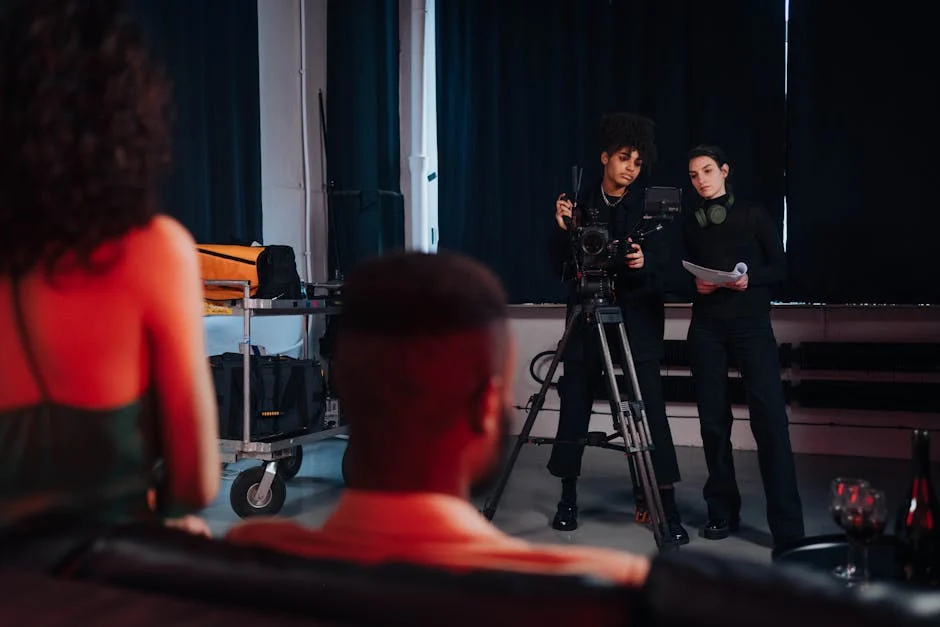Introduction to video production
Video production has undergone significant changes in recent years. Digital technology has revolutionized the industry, making it more accessible and affordable for content creators. Today, high-quality videos can be produced using consumer-grade equipment and software. This has opened up new opportunities for aspiring filmmakers and content creators to bring their vision to life. Whether it's for social media, marketing, or entertainment, video production has become an essential skill in the digital age.
The role of a creative director in video production
As a creative director in video production, you oversee the creative vision and execution of a project. Your role involves leading a team of professionals to ensure that the video aligns with the client's objectives and resonates with the target audience. You are responsible for guiding the overall aesthetic, storytelling, and brand messaging, while also supervising the technical aspects of production, such as cinematography, editing, and sound design. Your input is essential in every stage of the video production process, from brainstorming and script development to the final post-production touches.
Advancements in video production technology
Advancements in video production technology have revolutionized the industry in recent years. From the development of high-definition cameras to the rise of virtual reality and 360-degree video, these advancements have led to more immersive and engaging visual content. Additionally, the integration of artificial intelligence and machine learning has significantly enhanced the editing and post-production processes, allowing for more efficient workflows and innovative storytelling techniques. As a result, the possibilities for creative expression in video production have expanded tremendously, offering new and exciting opportunities for content creators and filmmakers.
Impact of digital media on video production
Digital media has vastly changed the landscape of video production. With the rise of digital platforms and online streaming services, there is an increased demand for diverse and engaging video content. This has led to the evolution of new storytelling techniques and formats, encouraging creative directors to explore innovative ways to captivate their audience. Moreover, digital media has also facilitated the accessibility and distribution of video content, allowing for a wider reach and influence. As a result, video production has become more dynamic and adaptable, reflecting the ever-changing digital landscape.
Creative storytelling in video production
In video production, creative storytelling is crucial for engaging your audience. Use compelling narratives and visually stimulating content to communicate your message effectively. Integrate emotion, suspense, and relatable characters into your videos to captivate your viewers. Incorporating unique perspectives, unexpected plot twists, and powerful imagery can help your video stand out and leave a lasting impact on your audience.
Collaborative process in video production
In video production, collaboration is key. Working closely with the director, cinematographer, and the rest of the team is essential to bring a creative vision to life. Communication is vital, ensuring that everyone is on the same page and working towards the same goal. Brainstorming sessions are common, where ideas are shared and combined to create the best possible outcome. Each team member plays a crucial role and contributes their expertise to the project. Feedback and constructive criticism are encouraged to refine and improve the final product. In the end, the collaborative process leads to a cohesive and impactful video production.
Importance of visual aesthetics and design
Visual aesthetics and design play a crucial role in video production, capturing the audience's attention and conveying the desired message effectively. The use of attractive visuals and thoughtful design enhances the overall appeal of the video, making it more engaging and memorable for viewers. It helps in creating a cohesive and professional look, elevating the quality of the content and leaving a lasting impression on the audience. Moreover, a well-crafted visual aesthetic and design can contribute to the storytelling aspect of the video, effectively conveying the intended emotions and themes. Good design and visual aesthetics are essential for grabbing the viewer's attention and creating a visual experience that resonates with them.
Challenges faced by creative directors in video production
Creative directors in video production often face challenges that require them to be adaptable and resourceful. Some of these challenges include managing tight timelines, keeping up with changing technology trends, and meeting client expectations within budget constraints. Additionally, they may also struggle with maintaining team morale and motivation throughout a project. Finding creative solutions to these challenges is essential for achieving successful outcomes in video production.
Future trends in video production
Future trends in video production include the increasing use of virtual and augmented reality (VR and AR), personalized video content, and the integration of artificial intelligence (AI) for video editing and production. Additionally, the rise of live streaming and interactive video experiences is expected to continue shaping the industry. Adaptation to these trends will be crucial for video producers and filmmakers to stay competitive in the evolving landscape of video production.
Conclusion: The evolving landscape of video production
In conclusion, the landscape of video production continues to evolve, embracing new technologies and trends. The rise of social media platforms has significantly impacted the way videos are created and consumed, leading to a greater emphasis on short, engaging content. As a creative director, it's essential to stay abreast of these changes and adapt strategies accordingly to ensure that the produced content remains relevant and impactful. The growing influence of user-generated content and the demand for authenticity also shape the future of video production, highlighting the need for adaptive storytelling and innovative production techniques.


